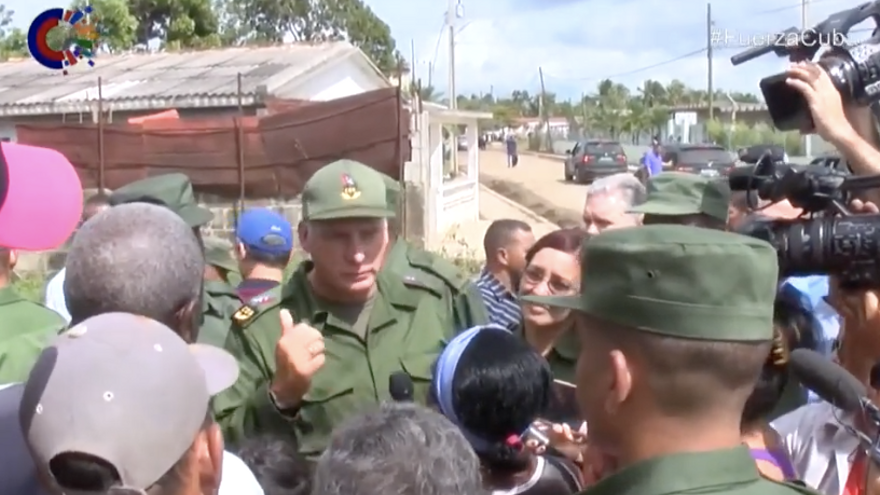
![]() 14ymedio, Havana, September 30, 2022 — In a display of populism, Miguel Díaz-Canel toured the towns most affected by Hurricane Ian in the west of the island. Dressed in military garb, Televisión Nacional dispensed with his titles of president and first secretary of the Party, and introduced him as the Chief of the National Defense Council.
14ymedio, Havana, September 30, 2022 — In a display of populism, Miguel Díaz-Canel toured the towns most affected by Hurricane Ian in the west of the island. Dressed in military garb, Televisión Nacional dispensed with his titles of president and first secretary of the Party, and introduced him as the Chief of the National Defense Council.
The photographers did the rest. Each snapshot aims to compare Díaz-Canel and Fidel Castro, which still excites elderly combatants and tries cast a little credibility on the figurehead hand-picked as president.
During his visit on Thursday to the municipality of Batabanó, in Mayabeque, one of those most affected by the floods, Díaz-Canel and his entourage had to continue on their way. “He is surrounded,” shouts a woman from the crowd that blocks the passage of the Civil Defense’s luxury vehicles, “and they don’t let the people speak.” “Walk so you can see,” they yell at him, calling the Ministry of the Interior agents who push people “brazen” and “snitches.”
“They mock the people” and then “they adorn him on the news,” concludes the same woman, who captures the moment with her phone, while the cars drive away from the center of Batabanó at full speed.
Hours later, the Noticiero Estelar [Stellar News] reported a “dialogue with the neighbors” of Batabanó, which meant a “summit moment.” “Díaz-Canel visited every corner where the population requested his presence to express their concerns,” said journalist Talía González.
In the images, protected by his bodyguard, he is seen hugging local officials, also in military dress, and greeting several families, who respond by repeating slogans and “long live the Revolution.” Díaz-Canel said he was very concerned about the “Batabanó issue” and about the people who lost their homes during the floods.
“We are making more progress,” he assured the residents, amid collapsed buildings, overflowing ditches and trees uprooted by the cyclone. “The things that are lacking here are also lacking in other parts of the country,” he snapped, “every day you have to chip away at the problems.”
“But here there are people here who have lost everything,” interrupted a woman, to which Díaz-Canel impassively responded with a litany of “uplifting” measures that the government had taken in the face of the hurricane. “We are guaranteeing the issue of mattresses,” he said with annoyance, “because the most important thing is for people to sleep on a mattress.”
According to Cubadebate, 85% of the damages in Mayabeque are concentrated in Batabanó, Melena del Sur and San Nicolás, due to flooding and crop damage. Díaz-Canel also toured the dilapidated Ernesto Guevara thermoelectric plant in Santa Cruz del Norte, which despite the promises of its technicians, is unable to provide enough energy to the National Electric System.
As the hours go by, it becomes more impossible for the government to keep the population satisfied and without protesting. Three days of electrical instability, failing telephone and internet services, shortages, and the impossibility of preserving foods that require refrigeration, are already triggering demonstrations in various parts of the country.
Protests and barricades in the Havana municipalities of El Cerro, Arroyo Naranjo, San Miguel del Padrón, in addition to cacerolazos [beating on pots and pans] in the provinces, such as those in Holguín, have launched a new wave of social informality.
Some public figures have expressed, also on social media, their desperation and their demand for political change in the country. This was the case of actor Ulyk Anello, sanctioned by Cuban Television in July for granting an interview to an independent journalist and placing a white rose on his Facebook profile; he lashed out at Díaz-Canel during a livestream on Instagram.
“Resign already,” said the artist, “where are the millions that were donated to you to repair the thermoelectric plants?” “Just leave already,” insisted Anello, who bemoaned that his family’s food was spoiling after three days without electricity.
The government response has been, once again, the threat of repression. Throughout the day yesterday, several vehicles of the Special Troops and the Armed Forces, in addition to patrol cars, have driven through the streets of the capital to intimidate Cubans.
In the midst of an energy crisis, the Editorial Office of 14ymedio recorded how the Ministry of the Armed Forces building, in the municipality of Plaza de la Revolución, remained with all its lights on Thursday night. Such waste, in a building usually dark at this time, suggests not only a display of power by the military leadership, but also a sign that they are paying attention so as to repress any possible protest.
Translated by: Silvia Suárez
____________
COLLABORATE WITH OUR WORK: The 14ymedio team is committed to practicing serious journalism that reflects Cuba’s reality in all its depth. Thank you for joining us on this long journey. We invite you to continue supporting us by becoming a member of 14ymedio now. Together we can continue transforming journalism in Cuba.
